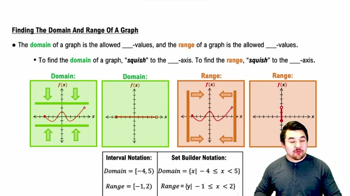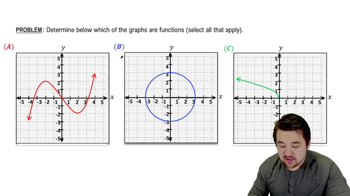Table of contents
- 0. Functions7h 52m
- Introduction to Functions16m
- Piecewise Functions10m
- Properties of Functions9m
- Common Functions1h 8m
- Transformations5m
- Combining Functions27m
- Exponent rules32m
- Exponential Functions28m
- Logarithmic Functions24m
- Properties of Logarithms34m
- Exponential & Logarithmic Equations35m
- Introduction to Trigonometric Functions38m
- Graphs of Trigonometric Functions44m
- Trigonometric Identities47m
- Inverse Trigonometric Functions48m
- 1. Limits and Continuity2h 2m
- 2. Intro to Derivatives1h 33m
- 3. Techniques of Differentiation3h 18m
- 4. Applications of Derivatives2h 38m
- 5. Graphical Applications of Derivatives6h 2m
- 6. Derivatives of Inverse, Exponential, & Logarithmic Functions2h 37m
- 7. Antiderivatives & Indefinite Integrals1h 26m
- 8. Definite Integrals4h 44m
- 9. Graphical Applications of Integrals2h 27m
- 10. Physics Applications of Integrals 2h 22m
0. Functions
Introduction to Functions
Problem 4.R.118b
Textbook Question
{Use of Tech} A family of superexponential functions Let ƒ(x) = (a + x)ˣ , where a > 0.
b. Describe the end behavior of f (near the left boundary of its domain and as x→∞).
 Verified step by step guidance
Verified step by step guidance1
First, identify the domain of the function ƒ(x) = (a + x)ˣ. Since the base (a + x) must be positive, the domain is x > -a.
Consider the behavior of ƒ(x) as x approaches the left boundary of its domain, which is x approaching -a from the right. As x gets closer to -a, the base (a + x) approaches zero, and the exponent x approaches -a. This results in the function approaching zero.
Next, analyze the behavior of ƒ(x) as x approaches infinity. As x becomes very large, both the base (a + x) and the exponent x increase. The function (a + x)ˣ grows rapidly, leading to superexponential growth.
Understand that superexponential growth means the function increases faster than exponential functions, due to the variable being both in the base and the exponent.
Summarize the end behavior: Near the left boundary of its domain, ƒ(x) approaches zero as x approaches -a. As x approaches infinity, ƒ(x) exhibits superexponential growth, increasing very rapidly.
 Verified video answer for a similar problem:
Verified video answer for a similar problem:This video solution was recommended by our tutors as helpful for the problem above
Video duration:
6mPlay a video:
Was this helpful?
Key Concepts
Here are the essential concepts you must grasp in order to answer the question correctly.
Superexponential Functions
Superexponential functions, like f(x) = (a + x)ˣ, grow faster than exponential functions as x increases. This means that as x approaches infinity, the function's value increases at an accelerating rate, which is crucial for understanding its end behavior.
Recommended video:

Properties of Functions
End Behavior
End behavior refers to the behavior of a function as the input approaches certain limits, such as negative or positive infinity. For f(x) = (a + x)ˣ, analyzing end behavior involves determining how the function behaves as x approaches the left boundary of its domain and as x approaches infinity.
Recommended video:

Cases Where Limits Do Not Exist
Domain of the Function
The domain of a function is the set of all possible input values (x) for which the function is defined. For f(x) = (a + x)ˣ, the domain is all real numbers greater than -a, which affects how we analyze the function's behavior at the left boundary and as x increases.
Recommended video:

Finding the Domain and Range of a Graph

 1:36m
1:36mWatch next
Master Introduction to Calculus Channel with a bite sized video explanation from Callie
Start learning




